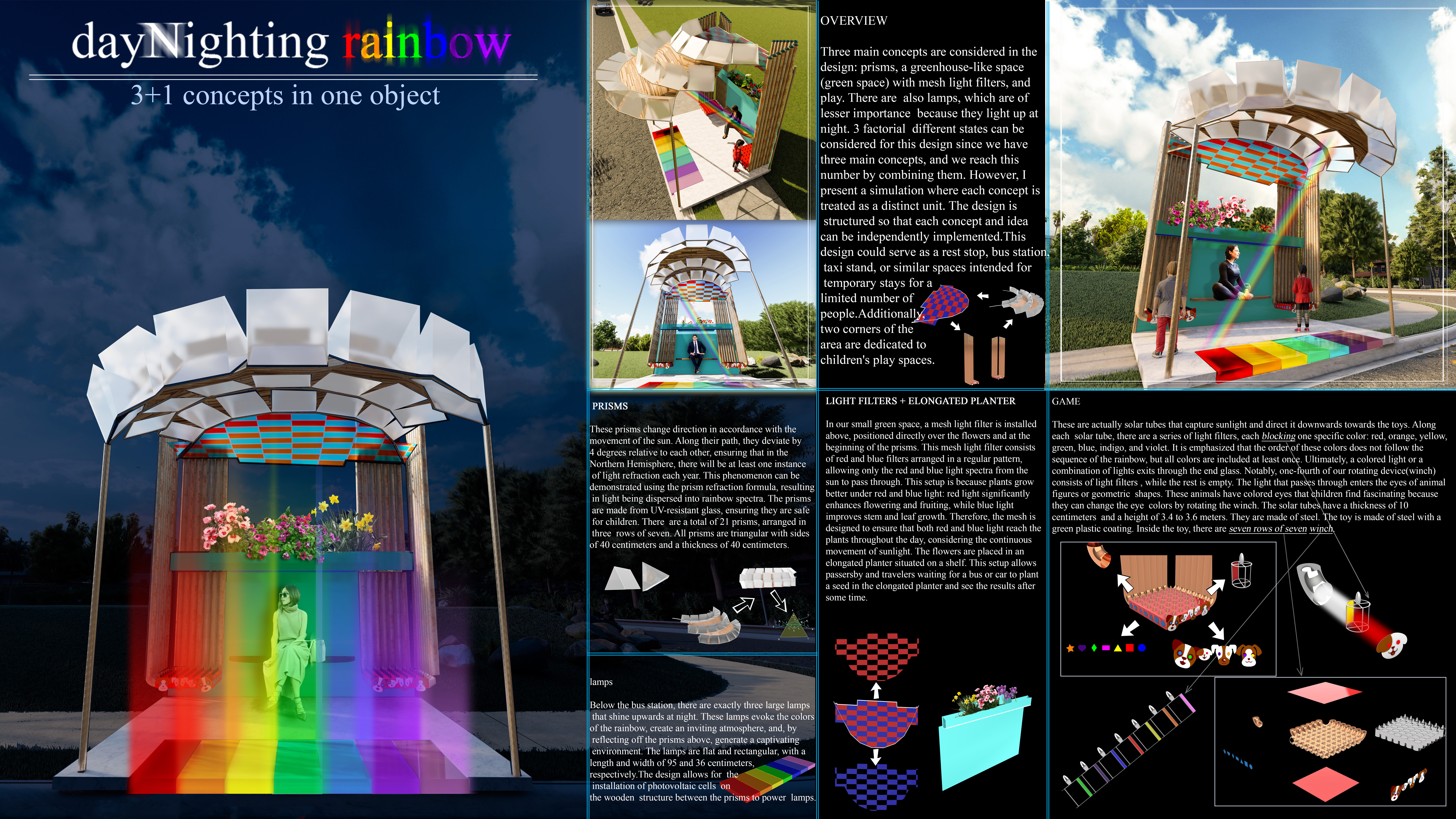2024 - dayNighting rainbow

Category
Daylight Investigations - Region 2: Eastern Europe and the Middle East
Students
Sajjad Saeedi Kelishomi
Teacher
Mamak Salavatian
School
Islamic Azad University
Country
Iran
Download
Download project board
Overview
Three main concepts are considered in the design: prisms, a greenhouse-like space (green space) with mesh light filters, and game. There are also lamps, which are of lesser importance because they light up at night. Three factorial different states can be considered for this design since we have three main concepts, and we reach this number by combining them. However, I present a simulation where each concept is treated as a distinct unit. The design is structured so that each concept and idea can be independently implemented. This design could serve as a rest stop, bus station, taxi stand, or similar spaces intended for temporary stays for a limited number of people. Additionally, two corners of the area are dedicated to children’s play spaces.
Prisms
These prisms change direction in accordance with the movement of the sun. Along their path, they deviate by 4 degrees relative to each other, ensuring that in the Northern Hemisphere, there will be at least one instance of light refraction each year. This phenomenon can be demonstrated using the prism refraction formula, resulting in light being dispersed into rainbow spectra. The prisms are made from UV-resistant glass, ensuring they are safe for children. There are a total of 21 prisms, arranged in three rows of seven. All prisms are triangular with sides of 40 centimeters and a thickness of 40 centimeters.
Game
These are actually solar tubes that capture sunlight and direct it downwards towards the toys. Along each solar tube, there are a series of light filters, each blocking one specific color: red, orange, yellow, green, blue, indigo, and violet. It is emphasized that the order of these colors does not follow the sequence of the rainbow, but all colors are included at least once. Ultimately, a colored light or a combination of lights exits through the end glass. Notably, one-fourth of our rotating device (winch) consists of light filters, while the rest is empty. The light that passes through enters the eyes of animal figures or geometric shapes. These animals have colored eyes that children find fascinating because they can change the eye colors by rotating the winch. The solar tubes have a thickness of 10 centimeters and a height of 3.4 to 3.6 meters. They are made of steel. The toy is made of steel with a green plastic coating. Inside the toy, there are seven rows of seven winch.
Light filters + Elongated planter
In our small green space, a mesh light filter is installed above, positioned directly over the flowers and at the beginning of the prisms. This mesh light filter consists of red and blue filters arranged in a regular pattern, allowing only the red and blue light spectra from the sun to pass through. This setup is because plants grow better under red and blue light: red light significantly enhances flowering and fruiting, while blue light improves stem and leaf growth. Therefore, the mesh is designed to ensure that both red and blue light reach the plants throughout the day, considering the continuous movement of sunlight. The flowers are placed in an elongated planter situated on a shelf. This setup allows passersby and travelers waiting for a bus or car to plant a seed in the elongated planter and see the results after some time.
Lamps
Below the bus station, there are exactly three large lamps that shine upwards at night. These lamps evoke the colors of the rainbow, create an inviting atmosphere, and, by reflecting off the prisms above, generate a captivating environment. The lamps are flat and rectangular, with a length and width of 95 and 36 centimeters, respectively. The design allows for the installation of photovoltaic cells on the wooden structure between the prisms to power the lamps.

























